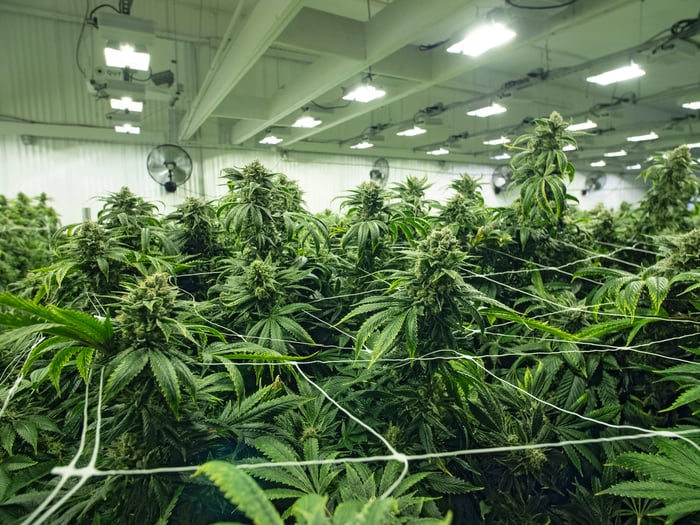When 2019 began, hopes were high within the investment community that cannabis stocks would remain unstoppable and blaze a path to profitability. This seemed a feasible expectation given that Canada had recently legalized adult-use marijuana, and numerous U.S. states appeared to be moving toward medical and/or recreational legalization.
But it wasn't meant to be.

Image source: Getty Images.
Canadian pot stocks have been a huge disappointment -- and things could get worse
Since the beginning of April 2019, pot stocks have been in a relatively precipitous decline marked by a host of regulatory issues. In the U.S., high tax rates on legal product in select states (ahem, California) have made it challenging for licensed producers to compete with the black market. Meanwhile, in Canada, supply issues have kept legal weed from reaching consumers.
But between the two markets, Canada has, unquestionably, been the bigger disappointment. We're talking about the first industrialized country to legalize recreational marijuana in the modern era completely dropping the ball on its chance to be a global cannabis leader. As a result, most Canadian pot stocks have shed anywhere from 50% to 90% of their value since the beginning of April 2019.
The unfortunate thing is that Canada's woes aren't over. In the months to come, there's a growing likelihood that we're going to witness a number of prominent Canadian pot stocks take large asset writedowns to reflect these industry struggles.
Canadian pot stock goodwill is a ticking time bomb
The most prominent issue with Canadian marijuana stocks, at least with regard to possible asset writedowns, is the goodwill they're lugging around on their balance sheets.
Goodwill is the premium paid above and beyond tangible and intangible assets that a purchasing business hopes to recoup over time. While some amount of goodwill is normal when making an acquisition -- that is, paying a premium is typical to coerce a buyout -- what cannabis stocks are carrying around appears unsustainably high.
For example, Aurora Cannabis (ACB 6.08%) had, at one time, in excess of 3 billion Canadian dollars in goodwill on its balance sheet. This was derived from making more than a dozen acquisitions since August 2016 and, in many instances, grossly overpaying for these deals. In fact, the CA$2.64 billion MedReleaf buyout is the most overpriced deal of all time, in my view, with CA$2 billion being classified as goodwill.

Image source: Getty Images.
Even after writing down CA$762.2 million in goodwill during the fiscal second quarter, Aurora is still carrying CA$2.42 billion of goodwill on its balance sheet, totaling 51% of its assets. Put in another context, more than half of Aurora's total assets are built on the hope of one day recouping what it overpaid for more than a dozen businesses.
Keep in mind that this isn't just a problem exclusive to Aurora Cannabis. Most Canadian marijuana stocks are carrying far too much goodwill on their balance sheets. Canopy Growth (CGC 9.19%), the largest pot stock by market cap, ended fiscal 2020 with CA$1.95 billion in goodwill, up from CA$1.49 billion at the end of fiscal 2019. Unfortunately, with Canopy's cash pile shrinking, its total assets declined by CA$1.7 billion year over year. The result is that Canopy's goodwill now accounts for almost 29% of its total assets.
Property and inventory writedowns could surprise folks
The worry I have for Canadian pot stock investors is that they might be blindsided by other asset writedowns in calendar year 2020 that they never saw coming. In addition to goodwill, impairments to inventory and property and to plants and equipment might await a number of popular Canadian marijuana stocks.
Generally speaking, having a healthy level of inventory is a good thing. Available inventory is necessary to fulfill wholesale agreements and meet heightened demand when necessary.
However, inventory levels for licensed producers in Canada have gotten out of control. Aggregate cannabis production far outweighs consumer demand, which for licensed producers has meant a significant surge in the dollar amount held in inventory. With few avenues to move this excess inventory, growers might be forced to significantly discount it, or perhaps even destroy it, just to get it off the books.
On a trailing-year basis, through March 31, 2020, Canopy Growth's inventory levels more than doubled to CA$391.1 million from CA$190.1 million, while Aurora Cannabis has seen its inventory more than triple to CA$251.2 million from CA$82.7 million.

Image source: Getty Images.
The valuations of property, plants, and equipment might also need some fine-tuning. Recently, Aurora Cannabis fire-sold its 1-million-square-foot Exeter greenhouse for a mere CA$8.6 million. Even though Exeter was never retrofit for cannabis production, this represents just a third of the CA$26 million MedReleaf paid when it purchased Exeter and 164 acres of land in 2018.
Likewise, Quebec-based HEXO (HEXO) announced a week ago that it had sold its Niagara facility for CA$10.25 million. The Niagara facility was acquired when HEXO purchased Newstrike Brands in an all-share deal that was worth CA$263 million when it was announced in March 2019. But in an effort to reduce its expenses and align its production with prevailing demand, HEXO shuttered Niagara and has now sold the property. It should be noted that HEXO has already taken sizable writedowns tied to its Newstrike Brands deal.
The point is that these assets were sold for a fraction of what they were once believed to be worth, and there's a very good chance that Canadian pot stocks haven't adjusted the value of their existing hard assets to reflect these more tempered greenhouse valuations.
In my view, very big asset writedowns await Canadian marijuana stocks in the coming quarters.





